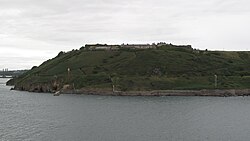Fort Davis, County Cork
| Fort Davis | |
|---|---|
| Dún an Dáibhisigh | |
| Near Whitegate in County Cork in Ireland | |

Fort Davis viewed from Cork Harbour
|
|
| Coordinates | 51°48′58″N 8°15′40″W / 51.816°N 8.261°WCoordinates: 51°48′58″N 8°15′40″W / 51.816°N 8.261°W |
| Type | Coastal defence fortification |
| Area | 74 acres (30 ha) |
| Site information | |
| Owner | Department of Defence |
| Open to the public |
No |
| Site history | |
| Built | 1607 (original castle) 1860s (significant reconstruction) |
| Events | Siege of Cork (1690), Treaty Port handover (1938) |
| Garrison information | |
| Occupants | British Armed Forces, Irish Defence Forces |
Fort Davis (Irish: Dún an Dáibhisigh; previously Fort Carlisle), is a coastal defence fortification close to Whitegate, County Cork, Ireland. Together with similar structures at Fort Mitchell (Spike Island), Fort Camden (Crosshaven), and Templebreedy Battery (also close to Crosshaven), the fort was built to defend the mouth of Cork Harbour. Though used as a fortification from the early 17th century, the current structures of the 74 acre site date primarily from the 1860s. Originally named Fort Carlisle and operated by the British Armed Forces, the fort was handed-over to the Irish Defence Forces in 1938, and renamed Fort Davis. The facility is owned by the Department of Defence, and is used as a military training site with no public access.
The coastline at Whitegate, north of Roche's Point, is at a strategic position overlooking the entrance to Cork Harbour – one of the world's largest natural harbours, and historically of defensive and naval importance to Ireland and the region. One of the earliest documented fortifications at this point was built prior to 1607, and came to be known as "Prince Rupert's Tower" (for Prince Rupert of the Rhine). By the period of the Williamite War (1689–1691) additional coastal defence fortifications were in place on the site, and known as "King John's Fort" (for John, King of England). Together with Fort Camden, this fort fell to Williamite forces under the Duke of Marlborough in the lead-up to the Siege of Cork (1690). Additional construction works were undertaken from the 1790s, and some of these tunnels and structures were used during the Napoleonic Wars (1803–1815) to house French prisoners of war.
...
Wikipedia

